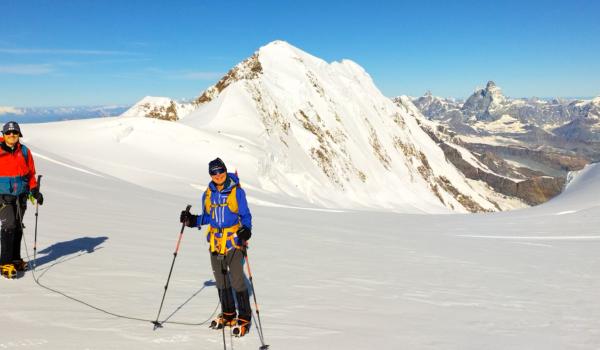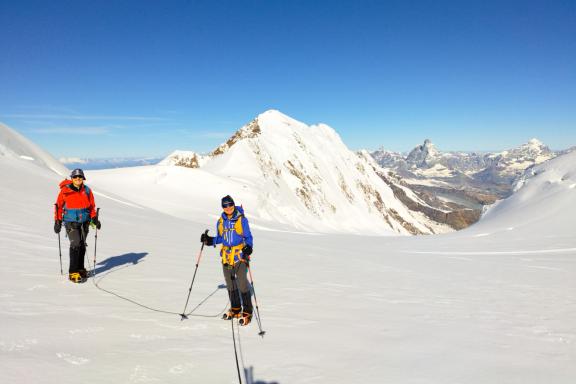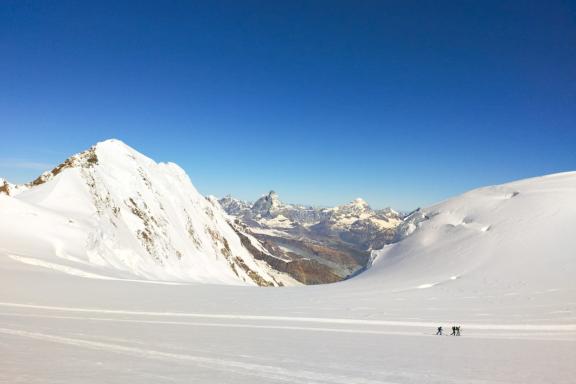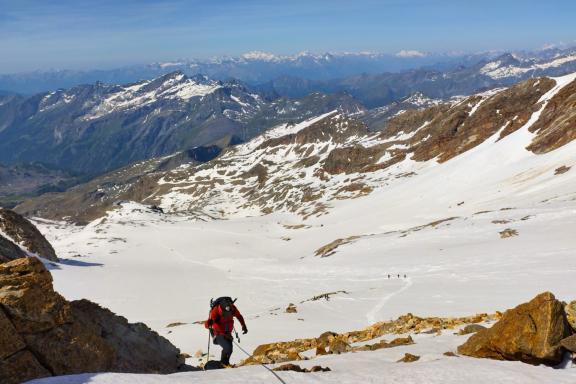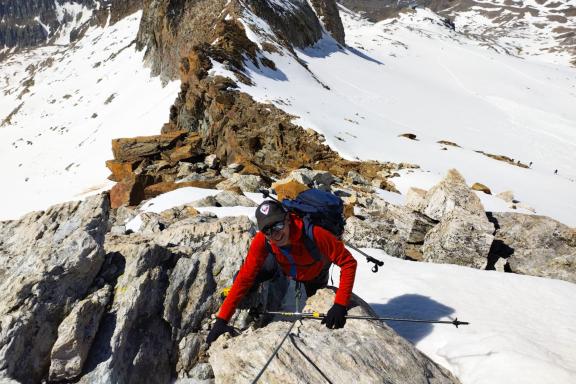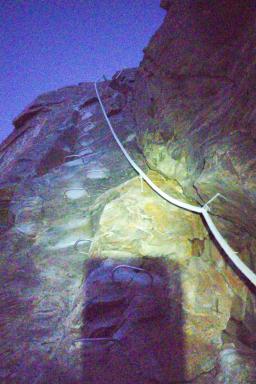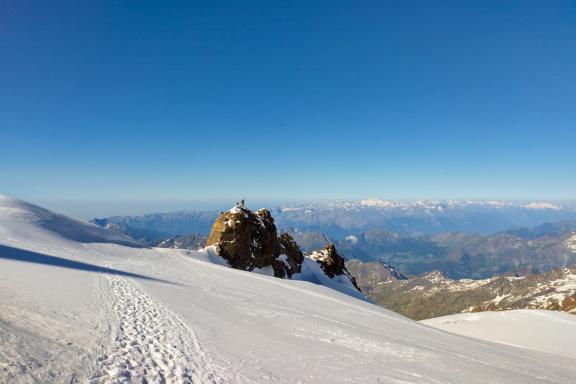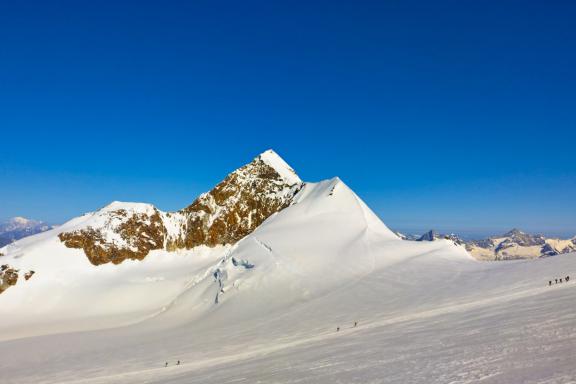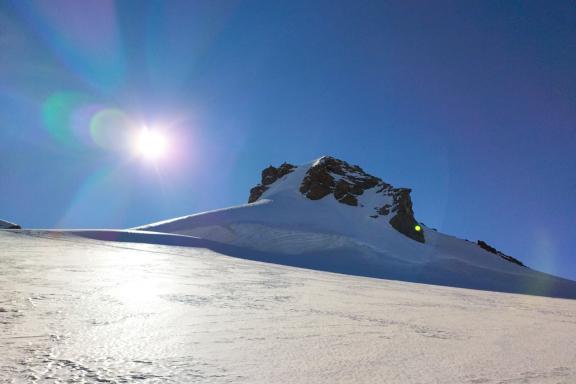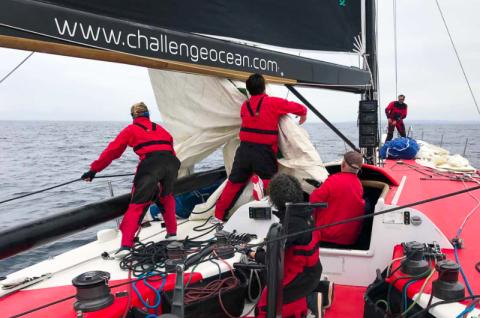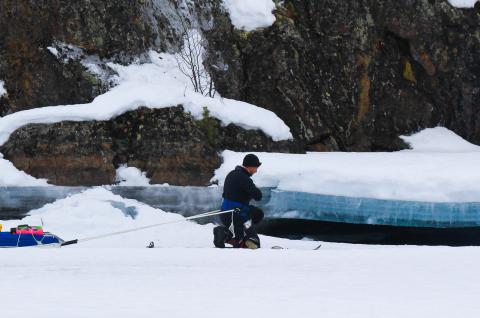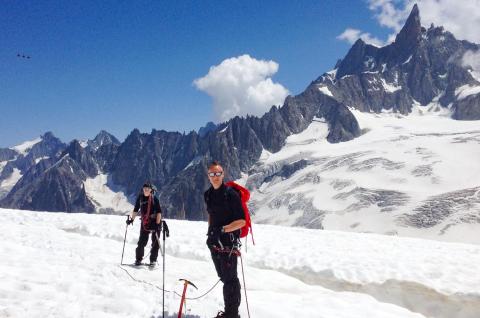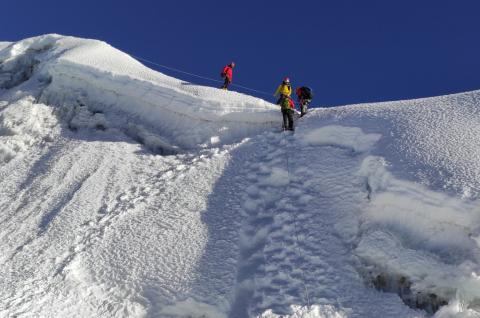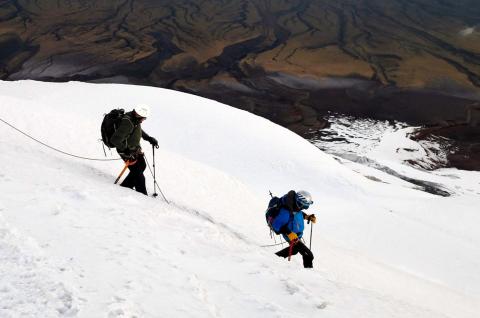A magnificent ascent on a still wild 4000er
Highlights
- Ascent accompanied by an experienced French mountain guide
- Ascent of Monte Rosa: 3 summits at over 4000 meters altitude
- A day of snow and ice exercise to acclimatize properly
- A technically accessible and progressive ascent
Guided by an experienced French mountain guide, this program proposes the ascent of Monte Rosa around 3 summits at over 4000 meters altitude, with a good chance of success if the weather is favorable. The 3 Monte Rosa peaks are, in the order of our ascent: Punta Giordani at 4061 meters, Piramide Vincent at 4210 meters and Punta Gnifetti at 4554 meters. We review the use of all our equipment, and look at belaying the leader and second of the roped party, applying protection, abseiling on ropes, etc. A 4-day program of increasing technical difficulty, open to beginners in crampon climbing. The days are aimed at climbers wishing to take on the challenge of crossing the 4000-meter mark several times. Serge talks to us about his countless climbs and shares his expert guide tips. A training program that allows us to enter mountaineering on the right foot. So that our first steps lead us to our most beautiful ascents!
Itinerary
Day1: Preparation and acclimatization at Monte Rosa
Day 1
We meet up in the Chamonix valley to check our mountaineering gear. We then drive to the Gressoney valley (not included in the price of the trip). Once there, we take the lifts up to 3200 meters. We find ourselves on the slopes of Punta Giordani, where we practice our acclimatization skills on snow and ice.
We review the climbing equipment needed for a safe ascent:
- ropes, the central element of mountaineering: attachment ropes, double and twin ropes, etc.
- belts, cords, carabiners and quickdraws, harnesses, etc.
- belay devices, carabiners and positioning for optimum hold.
Serge reminds us about the use of ropes. We spend some time on the importance of roping up and knots: knots, abseiling ropes, belaying and self-assurance at belay stations, etc. Then we start our progression by installing protection points, belaying, setting up belays and using the harness.
As well as setting protection points, Serge teaches us glacier progression techniques to improve our balance and movement:
- anchoring: how to obtain a solid anchor using your ice axe
- camponing, which varies according to the quality of the terrain: flat-footed (getting as many spikes as possible into the ice), mixed cramponing (one foot flat and the other on the front spikes), and frontal cramponing (only the front spikes are anchored in the ice).
- We are now ready for the ascent of the Piramide Vincent on day 2 of our trip. A final climb takes us to the Mantova refuge at 3400 meters.
Day 2: Piramide Vincent at 4210 meters
Day 2
Today we set off to climb the Piramide Vincent via its normal route. We are being vigilant, as we are passing close to crevasses. On the summit, we enjoy the view of the Italian Alps. We descend and spend the night at the Gnifetti hut, higher than the Mantova hut, at 3650 meters. This night prepares us for the next day's acclimatization process, when we attempt to climb to 4500 meters and the Gnifetti peak.
Day 3: towards 4500 meters and Punta Gnifetti at 4554 meters
Day 3
On this day, we set off towards 4500 meters, crossing the Col des Lys into Switzerland and then 4500 meters, before reaching the hut at the summit of Punta Gnifetti, the Margaritha hut, at 4554 meters. Then a long descent takes us back to the Mantova hut for a final, restful night at this altitude.
Day 4: Climb to Punta Giordani at 4060 meters
Day 4
Well acclimatized from the previous day, we head for this pretty summit above the Indren cable car. A 700-metre ascent on a glacier that has only slightly straightened out awaits us for this final challenge. Once we've reached the summit, we make our way back down to cable car 2 at the foot of the mountain. Return to Chamonix in the afternoon.
END OF EXPEDITION
For reasons that cannot be foreseen at this stage, such as unpredictable weather, the physical fitness or lack of fitness of participants or other circumstancess (customs formalities, road conditions, traffic, landslides, force majeure, etc.), your expedition leader may have to adapt the program, if necessary, to ensure the smooth running of your trip. He remains the sole judge and the one who guarantees your safety. Activity times are given as an indication and may vary from one participant to another.
The itinerary for all our expedition programs, or the ascent program for our high-mountain expeditions, are given here as a guide only. They are flexible enough to adapt to weather conditions with a few contingency days. In any case, you should follow the recommendations of your guide, who may suggest that you cancel your expedition due to weather, safety or physical conditions.
It is important to remember that this is a truly unsupported expedition, and that anything can happen. Expeditions Unlimited, your expedition leader, your guide or our local teams can in no way be held responsible.
Any costs incurred as a result of a change in the expedition schedule (extra nights' accommodation, extra flights) will be borne by the participants and not by the organizers. "Contingency days" refer to the expedition in the strict sense of the term (base camp/base camp in the mountains, departure point/exit point on a traverse, etc.).
Any early return of the expedition or of certain members only (early success, abandonment, etc.), generating costs for accommodation, meals, changes to air tickets or other activities not provided for in this program, will be charged in full to the participants.
Trip notes
Guiding
Your guide on this climb is usually Serge Bazin, one of the world's most experienced guides - see description above. On certain dates, however, and depending on the size of the group, another experienced guide may be appointed, who will be specified when you register.
Your guide will adapt the content of the course according to the technical and physical qualities of the participants, their current state of fitness and the weather. He makes all decisions necessary to ensure the course runs smoothly. His authority is paramount and inescapable. You must respect his decisions, as well as those taken collectively.
If, for reasons beyond our control and duly justified, your designated guide is unable to ensure your stay, he or she will be replaced by another experienced French mountain guide. The services would not be modified, the conditions of the stay would be identical and this change would not constitute a valid reason for cancellation.
Furthermore, we are always dependent on mountain weather conditions. A few days before departure or during your stay, your guide may have to modify the program for your safety. The alternative route (Monte Rosa, Grand Paradis, etc.) would then be determined with your guide and the other participants. The services would not be modified, the conditions of the stay would be identical and this change would not constitute a valid reason for cancellation.
For unpredictable reasons at this stage, like adverse weather conditions, insufficient physical condition of participants, insufficient competencies of participants related to the intended activities, your guide may decide to adjust the intended program and/or activities. At all times, his decision will be final on all matters likely to affect the safety and well-being of the trip.
Difficulty level
Level rated: challenging
This program is designed for participants who take part in a regular sports activity several times a week, including endurance activity.
You will need to carry your personal belongings and mountaineering gear, weighing around 7 to 9 kg (avoid excess). In your bag: picnic, spare gloves, thermos flask, snacks and energy bars for several days.
Technical level :
Open to beginners in crampon climbing, these days are aimed at those wishing to achieve a fine challenge by crossing the 4000-meter mark several times.
Physical level:
Regularly train in endurance sports (cycling, hiking, running, cross-country skiing, swimming) 2/3 times a month, at least 6 months before departure.
Guides are increasingly reluctant to supervise under-age climbers on challenging alpine ascents for reasons of responsibility, especially if they don't know the participant's level. To find out more, don't hesitate to ask us if one of the members of your group is a teenager, and together we'll assess the feasibility of the project according to his or her experience.
Technical difficulty
Mountaineering level: F like... Easy (Facile in French!)
In this program, the use of mountaineering equipment (crampons, harness, ice ax, ropes, etc.) is necessary but the route covered does not involve any technical difficulty. It is therefore aimed at beginners or even participants who have never practiced. Clearly, a little prior experience in the activity can be interesting, knowing how to equip yourself, knowing how to tie a few essential knots. The mountaineering courses at our Adventure School from three days are for you. And this technical rating applies of course to normal weather conditions: the difficulty can increase in the event of bad weather conditions, fresh snow on rocks, insufficient or lack of quality of the ice, etc. Likewise, the situation changes radically, for the same technical level, with the altitude, the weight of the bag, the lack of equipment on the route, the fatigue associated with the approach if it is long, the environment if particularly hostile, etc.
Programme sans aérien
Meet directly at your accommodation the day before your trip (time to be agreed with Serge).
Given the diverse origins of the participants on this trip, international outward and return flights are not included in this package. In most cases, we book flights on your behalf to ensure that the whole group arrives at the destination at the same time. We do not charge any fees for these air bookings. Please do not hesitate to contact us. If you book your own tickets, we will advise you on the ideal flight schedule to enable all participants to arrive within a reduced time frame. At the very least, you need tickets that can be modified.
Accommodations
Accommodation in mountain huts (refuges) in shared rooms and dormitories.
Meals
Full board: breakfast and dinner are taken in the refuge. Lunches are picnics.
Transfers / Transport
No transfers are planned. Participants' own vehicles can be used to get to nearby activity sites according to the program defined with Serge, in particular to get to the Gressoney valley in Italy. We can put participants in touch with each other for car pooling if necessary. Lift passes costing around 100 to 120 euros are included in this package.
Group size
The group is composed of 2 to 4 participants maximum. The number of participants is deliberately limited to allow for greater immersion, to avoid embarrassing our hosts, and to develop freedom and flexibility. However, the maximum number may be exceeded if the last person to register wishes to travel with one or more other people. The services will not be modified, and the conditions of the trip will remain the same.
Equipment
Personal equipment is not provided. However, a complete list is provided to allow you to check that you are taking what is necessary.
Our commitments to sustainable development
Our commitment to a better planet has been a reality since the beginning of our story but we always need to do more and better. Please find out more about our charter and our commitments in terms of sustainable development. We have drafted our charter and take action through six themes on which we act as concretely as possible, most often with you: social equity and cultural respect, preservation of water, waste management in expedition, protection of biodiversity, raise public awareness on these subjects and finally, the optimization and recovery of CO2 emissions.
Regarding carbon emissions, most of which are due to air travel, we calculated and communicated in 2018 on the carbon footprint of each of our programs, expressed in tonnes of CO2.
These calculations made us aware of the importance of the total carbon emissions generated by our activity. Also, we have committed in 2022 to a carbon reduction that we believe is unprecedented in the tourism industry, aiming to reduce the total emissions of our activity by 5% per year, taking 2019 as the reference year (3,430 tonnes of CO2). This commitment is in line with the trajectory of the Paris climate agreements of 2015, the current benchmark. Thus, in 2030, we commit ourselves not to exceed 2,160 tonnes of C02. Thus, our maximum “carbon” budget for 2024 is 2,950 tonnes and for 2025, this budget will be reduced to 2,800 tonnes. And so on until 2030. To find out more about all of our calculations and our commitments in terms of reducing our carbon emissions.
In addition, since 2019, we have been encouraging you when you book for your journey to contribute with a donation to an independent NGO, among the two we have selected that share the commitments made in our charter. We matched the amount of this donation to this program's carbon footprint. Thus, the journey you are considering generates 0,03 tons of CO2, which corresponds to a 100% donation of €1 for an estimated value today of €30 per tonne of CO2. This donation remains of course optional and you can decide to give between nothing and 100% of this amount. Since 2019, including covid years of 2020 and 2021, we have been able to collect thanks to you nearly €7,000 for these associations.
Please do not hesitate to come back to us with any questions you might have regarding this carbon footprint mechanism, our other sustainable développement commitments or even to share with us your experience through a chat or a mail at contact@secret-planet.com.
Serge Bazin, mountain guide
Originally from Toulon, Serge Bazin did his military service with the Alpine hunters in Bourg-Saint-Maurice. Trained as a topographer and surveyor, he moved to Chamonix in 1985. Together with a team of surveyors, they regularly measure the summit of Mont Blanc, which they climb on foot or skis. In 2021, they will celebrate their twentieth measurement!
For over 20 years, he has been concentrating on his job as a mountain guide, and has travelled all over the world, tackling rare or well-known summits, with participants he guides or with friends. He gives training courses, and prefers self-guided alpine-style expeditions in snow, ice, rock or mixed terrain. He has climbed several "big walls" (El Capitan eight times in Yosemite, USA).
He has been passionate about the Himalayas, and Nepal in particular, for 30 years, and returns there every year, either alone or with participants. Treks, traverses, ascents to 6000, 7000, 8000... His experience makes him one of France's most experienced high-altitude guides.
- Serge has guided participants to the summits of three eight-thousanders: Makalu (8475 m), Manaslu (8163 m) and Cho Oyu (8201 m).
In addition to numerous treks and passes approaching 6000 meters, his list of Asian climbs includes the following peaks, usually with participants he guided, and sometimes several times :
- Summits over 7000 meters: Himlung Himal (7127 m), Lhakpa Ri (7043 m), Korjenevskaya Peak (Tajikistan, 7105 m) and Lenin Peak (Kyrgyzstan, 7134 m), which he has climbed four or five times. He has also attempted the rare Nepalese peaks of Makalu 2 (7650 m – stop at 7500), Langtang Lirung (7200 m – stop at 7000), Ratna Chuli (7127 m– stop at 7000) and Gyanjing Kang (7200 m – stop at 6600 m) with other participants;
- Summits over 6000 meters: Ama Dablam (6856 m), Mera Peak (6470 m), Island Peak (6187 m), Lobuche Peak (6100 m), Pacharmo (6273 m), central Kongde Ri (6187 m), Kyajo Ri (6186 m), Daulhagiri VI – Ongde (6500 m), Chulu West (6419 m), Chulu East (6584 m), Thorung Peak (6100 m), Dhampus Peak (6012 m).
Since 1993, Serge has been offering children special "child walkers" trekking tours, which have seen some forty 8–18 year-olds trekking Nepal with him over the years. Some of them have since become guides...
Finally, he is a guide-trainer for ANENA - Association Nationale Etude Neige et Avalanches, a Grenoble-based training and information institute founded in 1971 by Louis Néel, winner of the Nobel Prize for physics.
In short, Serge has the experience and teaching know-how to optimize your expedition's chances of success, both technically and in terms of group management, both in terms of the pace at which the group builds up its strength and in terms of its progress, which are key elements in this type of expedition.
Departures and pricing
Please find below all dates and prices for this expedition. Prices are quoted "from" and may be adjusted notably according to the number of participants (see trip notes for details). Please note that dates and prices for years beyond 2024, when given, are for guidance only and are subject to change and readjustment to take account of current economic realities.
No date works for me!
I initiate a new datePrice includes
- Transfers by private vehicle between activity sites
- Meals as mentioned in the day-by-day guide
- Accommodation in mountain huts in shared rooms and dormitories
- 1 experienced French mountain guide
- Collective technical equipment required for the program (fixed ropes, rigging, etc.)
- Climbing taxes and permits, government environmental taxes
- Various reservations, refuges and lifts
Price does not include
- A&R transport to one of the meeting points
- Local transport in the Chamonix valley
- Personal equipment (boots/crampons)
- Personal insurance
- Overnight accommodation the day before the race and on D4 if necessary.
- Any costs arising from a change of program due to weather conditions, lift failure or other reasons.
- Picnic lunches.
- Drinks in mountain huts, extras in accommodation, personal expenses, anything not included in the "price includes" section.
- Travel to and from Gressoney
- Water during meals in refuges, midday meals or picnics.
- Travel in Italy
